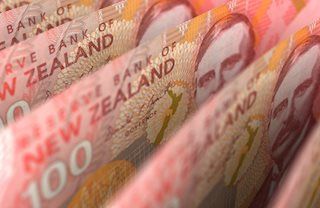NZD/USD maintains position above 0.5900 after China PMI, awaits Fed policy decision
|
- NZD/USD advances due to dovish sentiment surrounding the Fed’s interest rates trajectory.
- The US Dollar extends its decline due to growing anticipation of a Fed rate cut in September.
- The Kiwi Dollar may struggle due to rising odds of an early rate cut by the RBNZ.
NZD/USD trades around 0.5910 during the European session on Wednesday, extending its gains for the second consecutive session after hitting a three-month low at 0.5857 on Monday. This upside of the NZD/USD could be attributed to the dovish sentiment surrounding the Federal Reserve’s (Fed) interest rates trajectory.
The Fed is expected to keep rates unchanged at its policy meeting scheduled for Wednesday. However, there is growing anticipation of a rate cut in September. Additionally, signs of cooling inflation and easing labor market conditions in the United States are further fueling expectations of multiple rate cuts by the Fed this year, potentially totaling three cuts. These speculations are putting pressure on the US Dollar.
In New Zealand, Building Permits dropped by 13.8% month-on-month in June, following an upwardly revised 1.9% decrease in the previous month. This marks the steepest decline since February 2021. Additionally, the ANZ Business Confidence index surged to 27.1 in July from 6.1 in June, marking the first rise in six months and reaching its highest level since February.
Speculation about an early interest rate cut by the Reserve Bank of New Zealand (RBNZ) might limit the upside potential of the NZD/USD pair. Investors are expecting potential rate cuts from the RBNZ, with traders currently indicating a 44% probability of such a move due to recent weak inflation and labor data.
The New Zealand Dollar (NZD) received support after the release of the Chinese Manufacturing Purchasing Managers' Index (PMI) data for July, considering China is a major trading partner of New Zealand.
China’s NBS Manufacturing PMI posted a reading of 49.4 for July, slightly above the expected 49.3 but below the prior 49.5. Meanwhile, the Non-Manufacturing PMI came in at 50.2 as expected. Since changes in the Chinese economy can significantly impact the New Zealand market, these PMI readings are particularly relevant.
New Zealand Dollar FAQs
The New Zealand Dollar (NZD), also known as the Kiwi, is a well-known traded currency among investors. Its value is broadly determined by the health of the New Zealand economy and the country’s central bank policy. Still, there are some unique particularities that also can make NZD move. The performance of the Chinese economy tends to move the Kiwi because China is New Zealand’s biggest trading partner. Bad news for the Chinese economy likely means less New Zealand exports to the country, hitting the economy and thus its currency. Another factor moving NZD is dairy prices as the dairy industry is New Zealand’s main export. High dairy prices boost export income, contributing positively to the economy and thus to the NZD.
The Reserve Bank of New Zealand (RBNZ) aims to achieve and maintain an inflation rate between 1% and 3% over the medium term, with a focus to keep it near the 2% mid-point. To this end, the bank sets an appropriate level of interest rates. When inflation is too high, the RBNZ will increase interest rates to cool the economy, but the move will also make bond yields higher, increasing investors’ appeal to invest in the country and thus boosting NZD. On the contrary, lower interest rates tend to weaken NZD. The so-called rate differential, or how rates in New Zealand are or are expected to be compared to the ones set by the US Federal Reserve, can also play a key role in moving the NZD/USD pair.
Macroeconomic data releases in New Zealand are key to assess the state of the economy and can impact the New Zealand Dollar’s (NZD) valuation. A strong economy, based on high economic growth, low unemployment and high confidence is good for NZD. High economic growth attracts foreign investment and may encourage the Reserve Bank of New Zealand to increase interest rates, if this economic strength comes together with elevated inflation. Conversely, if economic data is weak, NZD is likely to depreciate.
The New Zealand Dollar (NZD) tends to strengthen during risk-on periods, or when investors perceive that broader market risks are low and are optimistic about growth. This tends to lead to a more favorable outlook for commodities and so-called ‘commodity currencies’ such as the Kiwi. Conversely, NZD tends to weaken at times of market turbulence or economic uncertainty as investors tend to sell higher-risk assets and flee to the more-stable safe havens.
Information on these pages contains forward-looking statements that involve risks and uncertainties. Markets and instruments profiled on this page are for informational purposes only and should not in any way come across as a recommendation to buy or sell in these assets. You should do your own thorough research before making any investment decisions. FXStreet does not in any way guarantee that this information is free from mistakes, errors, or material misstatements. It also does not guarantee that this information is of a timely nature. Investing in Open Markets involves a great deal of risk, including the loss of all or a portion of your investment, as well as emotional distress. All risks, losses and costs associated with investing, including total loss of principal, are your responsibility. The views and opinions expressed in this article are those of the authors and do not necessarily reflect the official policy or position of FXStreet nor its advertisers.